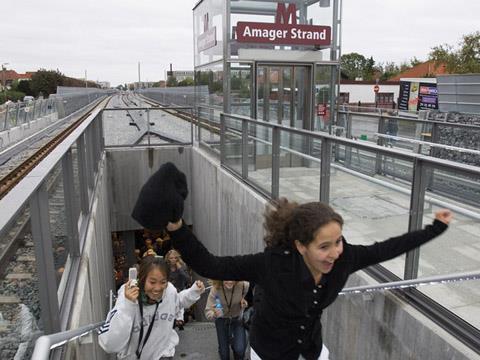
CROWN PRINCE Frederik of Denmark opened an extension of København Metro line M2 to Lufthavnen station at the city’s airport on September 28, marking the completion of the two automated light metro lines envisaged in the initial scheme finalised by development authority Ørestadsselskabet in 1996.
The Prince arrived at Lufthavnen by metro, and after speeches the 4·5 km extension was officially opened to the public with an afternoon of free rides. Trains run every 4 min in the peaks and every 6 min off peak, with a 15 min headway continuing throughout the night to give a 24 h service. Passengers are whisked from the airport to Kongens Nytorv in the city centre in 13 min, and services are fully integrated into the city’s multi-modal zonal fare structure.
The line is double track, and terminates adjacent to Terminal 3 and the Hilton Hotel, with covered walking routes to both. All but 0·5 km of the line is above ground, making use of the alignment of the former Amagerbanen railway serving Kastrup, and there are five stations on the extension.
The metro’s three-car Ansaldo Breda light metro trains are driverless and can run unmanned, although there are staff present throughout the system and most trains have a steward on board to assist passengers and provide a security presence.
Staged construction
Promoted by Ørestadsselskabet, a development body set up 15 years ago by the København city and Danish national governments, the capital’s metro was built in four phases. The two lines forming Phase 1 opened in October 2002, and Phases 2a and 2b extended the lines westwards in May and October 2003. A separate civil works contract was let for Phase 3 from Lergravsparken to Lufthavnen, but electrical and railway systems work was undertaken as an option on the contract for the first phase (RG 1.03).
The Metro Service consortium of Ansaldo STS and Serco is responsible for operations and maintenance under a performance-based contract with Ørestadsselskabet. This was extended from five to eight years at the start of 2007, and now runs to 2010. Agreement has been reached for Ansaldo STS to buy-out Serco’s stake in the consortium by the end of this year.
City Circle Line
The airport extension completes the initial network, but planning is now well underway for the next phase, the construction of a ‘City Circle’ ring line M3/M4 serving the city centre and main station as well as northern and western suburbs not currently served by the Metro or S-Tog heavy rail.
Preferred consultants for the development of this Phase 4 have recently been selected, and tendering is expected to begin in 2008. Two stations on the City Circle Line will provide interchanges with the existing lines, but it is not currently intended to physically connect them as it is felt this would give an unfair advantage in the bidding process to Ansaldo STS, supplier of the automation and other railway systems for the existing lines M1 and M2.
Ansaldo STS has confirmed it will be bidding for the City Circle, and will be proposing the same automated light metro technology used on lines M1 and M2. The Italian firm sees København as a showcase for its turnkey metro capabilities, and since the opening of the first phase in 2002 virtually identical technologies have been selected for Brescia, Roma Line C, Thessaloniki and Milano Line 5; one transport authority even went as far as asking to licence the distinctive clocks which had been specially designed for the stations in København.


